Analyzing Quality Credit Framework, Midwife & Health Visitor Roles
VerifiedAdded on 2023/06/10
|7
|1552
|423
Essay
AI Summary
This essay provides an overview of the Level Two and Level Three Quality Credit Framework qualifications, detailing the skills and capabilities of individuals at each level and suitable job roles within healthcare. It compares and contrasts the roles of midwives and health visitors in the UK healthcare system, highlighting their similarities and differences in caring for children and new parents. The essay also discusses the advantages and disadvantages of multiagency working in healthcare, emphasizing the benefits of shared resources and potential conflicts. Finally, it includes a personal development plan outlining goals, strengths, and areas for development to complete a Health and Social Care course and pursue a nursing degree.

Running Head: ASSIGNMENT UNIT 2 1
Assignment Unit 2
Author’s Name
Institution
Date
Assignment Unit 2
Author’s Name
Institution
Date
Paraphrase This Document
Need a fresh take? Get an instant paraphrase of this document with our AI Paraphraser
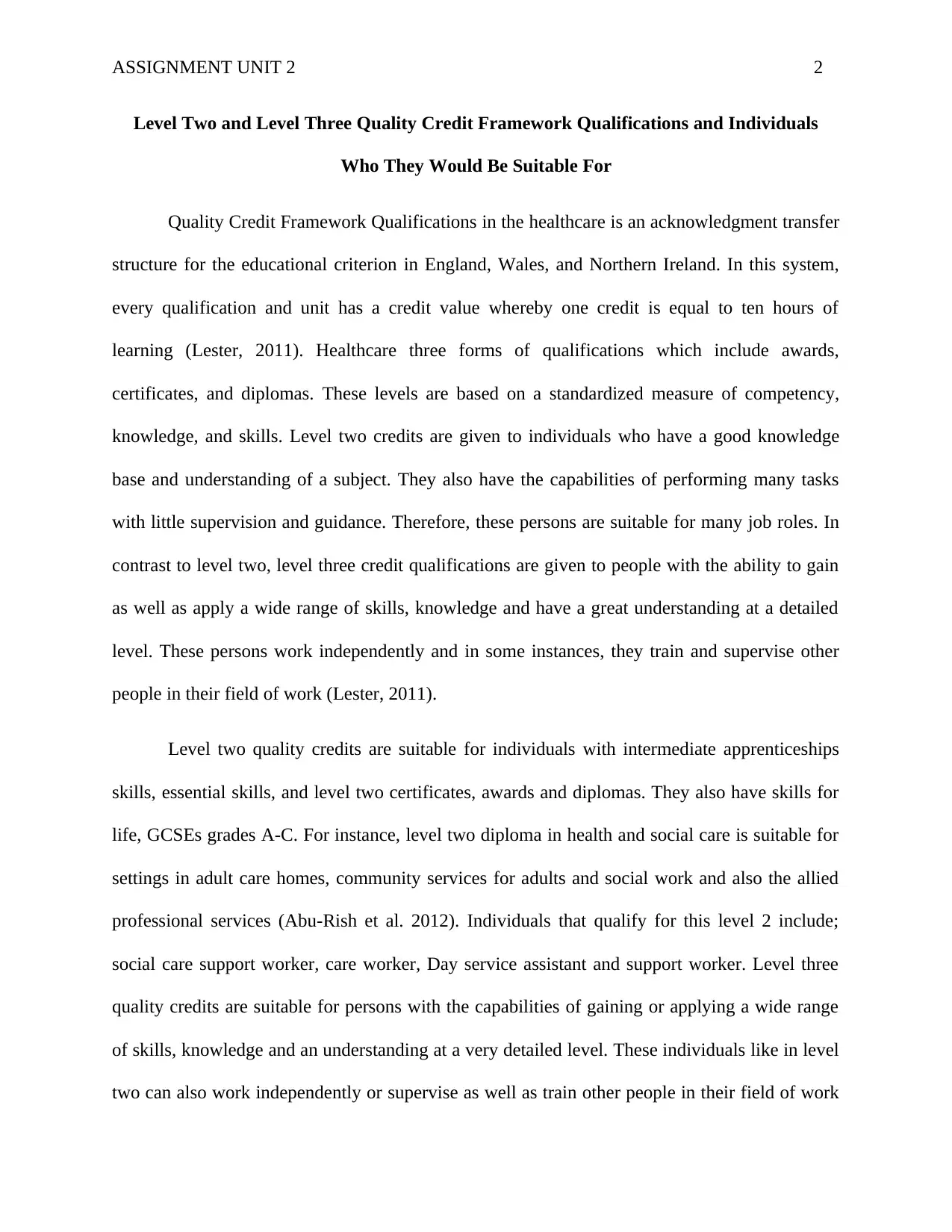
ASSIGNMENT UNIT 2 2
Level Two and Level Three Quality Credit Framework Qualifications and Individuals
Who They Would Be Suitable For
Quality Credit Framework Qualifications in the healthcare is an acknowledgment transfer
structure for the educational criterion in England, Wales, and Northern Ireland. In this system,
every qualification and unit has a credit value whereby one credit is equal to ten hours of
learning (Lester, 2011). Healthcare three forms of qualifications which include awards,
certificates, and diplomas. These levels are based on a standardized measure of competency,
knowledge, and skills. Level two credits are given to individuals who have a good knowledge
base and understanding of a subject. They also have the capabilities of performing many tasks
with little supervision and guidance. Therefore, these persons are suitable for many job roles. In
contrast to level two, level three credit qualifications are given to people with the ability to gain
as well as apply a wide range of skills, knowledge and have a great understanding at a detailed
level. These persons work independently and in some instances, they train and supervise other
people in their field of work (Lester, 2011).
Level two quality credits are suitable for individuals with intermediate apprenticeships
skills, essential skills, and level two certificates, awards and diplomas. They also have skills for
life, GCSEs grades A-C. For instance, level two diploma in health and social care is suitable for
settings in adult care homes, community services for adults and social work and also the allied
professional services (Abu-Rish et al. 2012). Individuals that qualify for this level 2 include;
social care support worker, care worker, Day service assistant and support worker. Level three
quality credits are suitable for persons with the capabilities of gaining or applying a wide range
of skills, knowledge and an understanding at a very detailed level. These individuals like in level
two can also work independently or supervise as well as train other people in their field of work
Level Two and Level Three Quality Credit Framework Qualifications and Individuals
Who They Would Be Suitable For
Quality Credit Framework Qualifications in the healthcare is an acknowledgment transfer
structure for the educational criterion in England, Wales, and Northern Ireland. In this system,
every qualification and unit has a credit value whereby one credit is equal to ten hours of
learning (Lester, 2011). Healthcare three forms of qualifications which include awards,
certificates, and diplomas. These levels are based on a standardized measure of competency,
knowledge, and skills. Level two credits are given to individuals who have a good knowledge
base and understanding of a subject. They also have the capabilities of performing many tasks
with little supervision and guidance. Therefore, these persons are suitable for many job roles. In
contrast to level two, level three credit qualifications are given to people with the ability to gain
as well as apply a wide range of skills, knowledge and have a great understanding at a detailed
level. These persons work independently and in some instances, they train and supervise other
people in their field of work (Lester, 2011).
Level two quality credits are suitable for individuals with intermediate apprenticeships
skills, essential skills, and level two certificates, awards and diplomas. They also have skills for
life, GCSEs grades A-C. For instance, level two diploma in health and social care is suitable for
settings in adult care homes, community services for adults and social work and also the allied
professional services (Abu-Rish et al. 2012). Individuals that qualify for this level 2 include;
social care support worker, care worker, Day service assistant and support worker. Level three
quality credits are suitable for persons with the capabilities of gaining or applying a wide range
of skills, knowledge and an understanding at a very detailed level. These individuals like in level
two can also work independently or supervise as well as train other people in their field of work
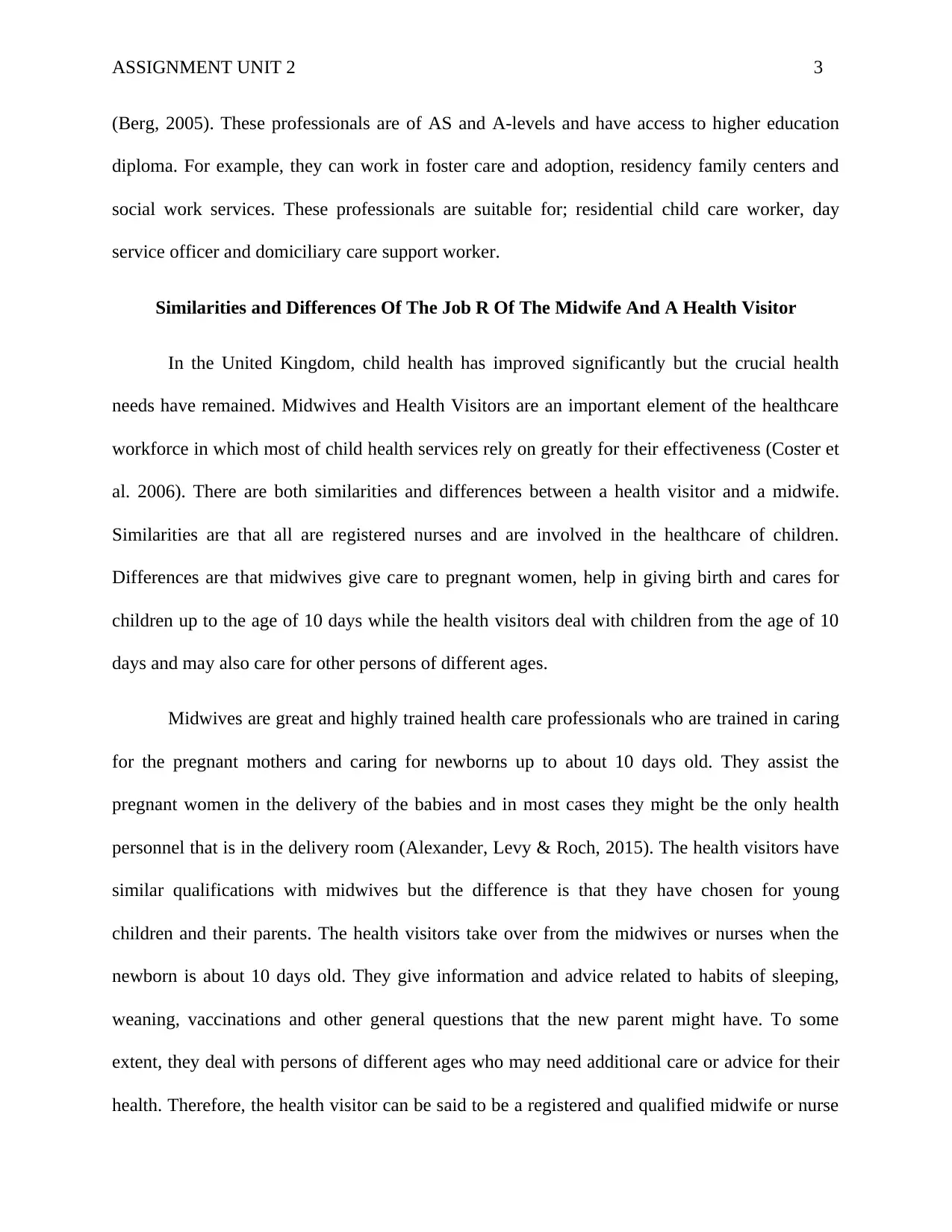
ASSIGNMENT UNIT 2 3
(Berg, 2005). These professionals are of AS and A-levels and have access to higher education
diploma. For example, they can work in foster care and adoption, residency family centers and
social work services. These professionals are suitable for; residential child care worker, day
service officer and domiciliary care support worker.
Similarities and Differences Of The Job R Of The Midwife And A Health Visitor
In the United Kingdom, child health has improved significantly but the crucial health
needs have remained. Midwives and Health Visitors are an important element of the healthcare
workforce in which most of child health services rely on greatly for their effectiveness (Coster et
al. 2006). There are both similarities and differences between a health visitor and a midwife.
Similarities are that all are registered nurses and are involved in the healthcare of children.
Differences are that midwives give care to pregnant women, help in giving birth and cares for
children up to the age of 10 days while the health visitors deal with children from the age of 10
days and may also care for other persons of different ages.
Midwives are great and highly trained health care professionals who are trained in caring
for the pregnant mothers and caring for newborns up to about 10 days old. They assist the
pregnant women in the delivery of the babies and in most cases they might be the only health
personnel that is in the delivery room (Alexander, Levy & Roch, 2015). The health visitors have
similar qualifications with midwives but the difference is that they have chosen for young
children and their parents. The health visitors take over from the midwives or nurses when the
newborn is about 10 days old. They give information and advice related to habits of sleeping,
weaning, vaccinations and other general questions that the new parent might have. To some
extent, they deal with persons of different ages who may need additional care or advice for their
health. Therefore, the health visitor can be said to be a registered and qualified midwife or nurse
(Berg, 2005). These professionals are of AS and A-levels and have access to higher education
diploma. For example, they can work in foster care and adoption, residency family centers and
social work services. These professionals are suitable for; residential child care worker, day
service officer and domiciliary care support worker.
Similarities and Differences Of The Job R Of The Midwife And A Health Visitor
In the United Kingdom, child health has improved significantly but the crucial health
needs have remained. Midwives and Health Visitors are an important element of the healthcare
workforce in which most of child health services rely on greatly for their effectiveness (Coster et
al. 2006). There are both similarities and differences between a health visitor and a midwife.
Similarities are that all are registered nurses and are involved in the healthcare of children.
Differences are that midwives give care to pregnant women, help in giving birth and cares for
children up to the age of 10 days while the health visitors deal with children from the age of 10
days and may also care for other persons of different ages.
Midwives are great and highly trained health care professionals who are trained in caring
for the pregnant mothers and caring for newborns up to about 10 days old. They assist the
pregnant women in the delivery of the babies and in most cases they might be the only health
personnel that is in the delivery room (Alexander, Levy & Roch, 2015). The health visitors have
similar qualifications with midwives but the difference is that they have chosen for young
children and their parents. The health visitors take over from the midwives or nurses when the
newborn is about 10 days old. They give information and advice related to habits of sleeping,
weaning, vaccinations and other general questions that the new parent might have. To some
extent, they deal with persons of different ages who may need additional care or advice for their
health. Therefore, the health visitor can be said to be a registered and qualified midwife or nurse
⊘ This is a preview!⊘
Do you want full access?
Subscribe today to unlock all pages.

Trusted by 1+ million students worldwide
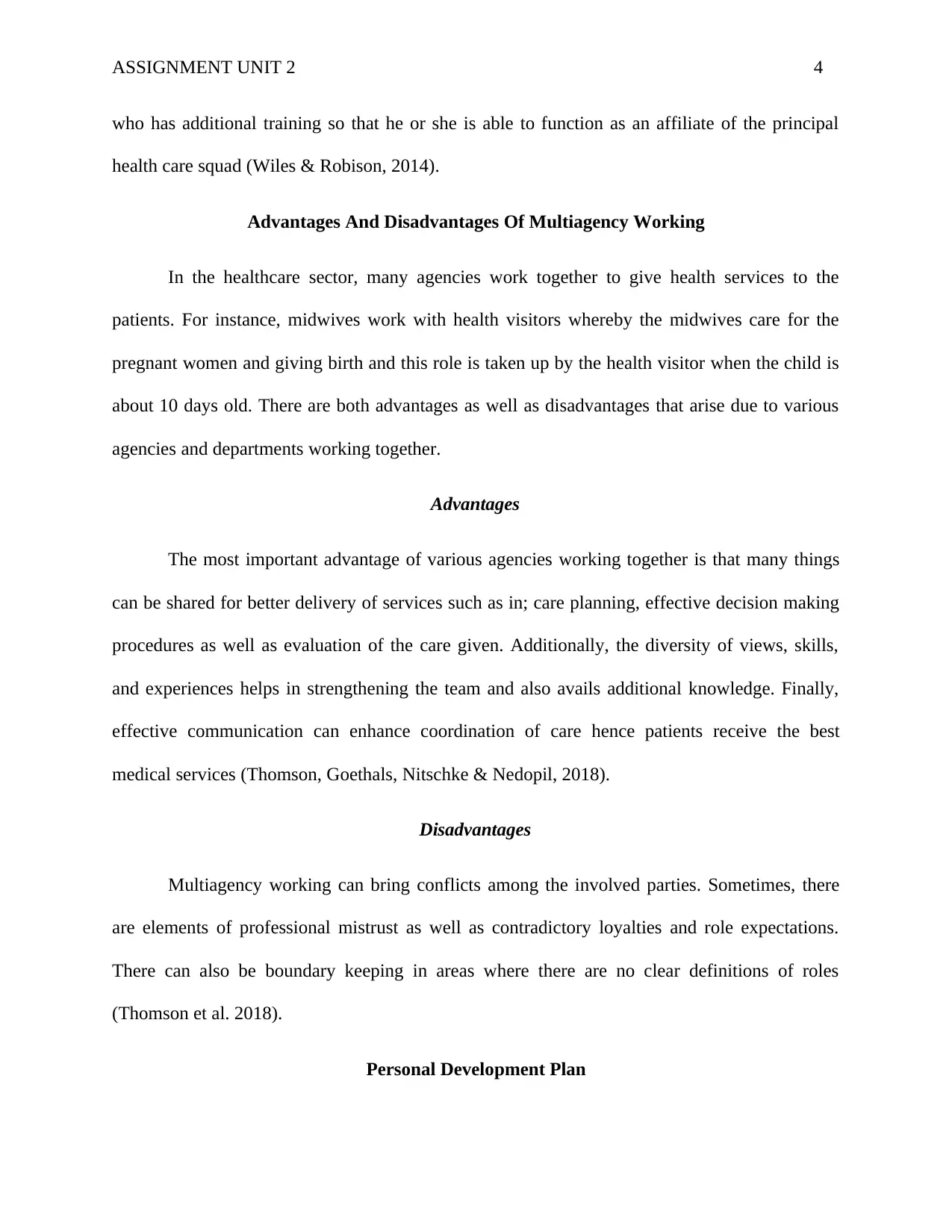
ASSIGNMENT UNIT 2 4
who has additional training so that he or she is able to function as an affiliate of the principal
health care squad (Wiles & Robison, 2014).
Advantages And Disadvantages Of Multiagency Working
In the healthcare sector, many agencies work together to give health services to the
patients. For instance, midwives work with health visitors whereby the midwives care for the
pregnant women and giving birth and this role is taken up by the health visitor when the child is
about 10 days old. There are both advantages as well as disadvantages that arise due to various
agencies and departments working together.
Advantages
The most important advantage of various agencies working together is that many things
can be shared for better delivery of services such as in; care planning, effective decision making
procedures as well as evaluation of the care given. Additionally, the diversity of views, skills,
and experiences helps in strengthening the team and also avails additional knowledge. Finally,
effective communication can enhance coordination of care hence patients receive the best
medical services (Thomson, Goethals, Nitschke & Nedopil, 2018).
Disadvantages
Multiagency working can bring conflicts among the involved parties. Sometimes, there
are elements of professional mistrust as well as contradictory loyalties and role expectations.
There can also be boundary keeping in areas where there are no clear definitions of roles
(Thomson et al. 2018).
Personal Development Plan
who has additional training so that he or she is able to function as an affiliate of the principal
health care squad (Wiles & Robison, 2014).
Advantages And Disadvantages Of Multiagency Working
In the healthcare sector, many agencies work together to give health services to the
patients. For instance, midwives work with health visitors whereby the midwives care for the
pregnant women and giving birth and this role is taken up by the health visitor when the child is
about 10 days old. There are both advantages as well as disadvantages that arise due to various
agencies and departments working together.
Advantages
The most important advantage of various agencies working together is that many things
can be shared for better delivery of services such as in; care planning, effective decision making
procedures as well as evaluation of the care given. Additionally, the diversity of views, skills,
and experiences helps in strengthening the team and also avails additional knowledge. Finally,
effective communication can enhance coordination of care hence patients receive the best
medical services (Thomson, Goethals, Nitschke & Nedopil, 2018).
Disadvantages
Multiagency working can bring conflicts among the involved parties. Sometimes, there
are elements of professional mistrust as well as contradictory loyalties and role expectations.
There can also be boundary keeping in areas where there are no clear definitions of roles
(Thomson et al. 2018).
Personal Development Plan
Paraphrase This Document
Need a fresh take? Get an instant paraphrase of this document with our AI Paraphraser
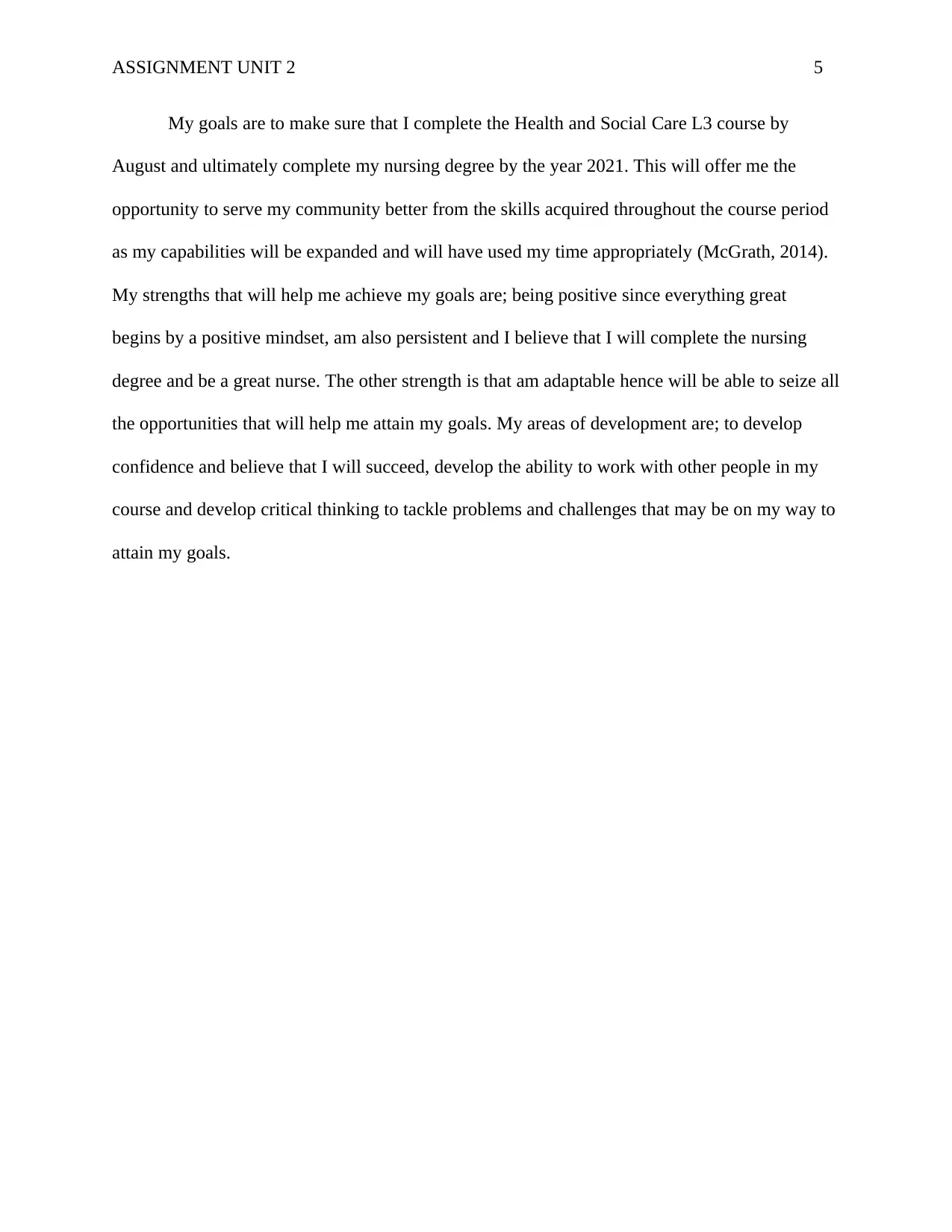
ASSIGNMENT UNIT 2 5
My goals are to make sure that I complete the Health and Social Care L3 course by
August and ultimately complete my nursing degree by the year 2021. This will offer me the
opportunity to serve my community better from the skills acquired throughout the course period
as my capabilities will be expanded and will have used my time appropriately (McGrath, 2014).
My strengths that will help me achieve my goals are; being positive since everything great
begins by a positive mindset, am also persistent and I believe that I will complete the nursing
degree and be a great nurse. The other strength is that am adaptable hence will be able to seize all
the opportunities that will help me attain my goals. My areas of development are; to develop
confidence and believe that I will succeed, develop the ability to work with other people in my
course and develop critical thinking to tackle problems and challenges that may be on my way to
attain my goals.
My goals are to make sure that I complete the Health and Social Care L3 course by
August and ultimately complete my nursing degree by the year 2021. This will offer me the
opportunity to serve my community better from the skills acquired throughout the course period
as my capabilities will be expanded and will have used my time appropriately (McGrath, 2014).
My strengths that will help me achieve my goals are; being positive since everything great
begins by a positive mindset, am also persistent and I believe that I will complete the nursing
degree and be a great nurse. The other strength is that am adaptable hence will be able to seize all
the opportunities that will help me attain my goals. My areas of development are; to develop
confidence and believe that I will succeed, develop the ability to work with other people in my
course and develop critical thinking to tackle problems and challenges that may be on my way to
attain my goals.
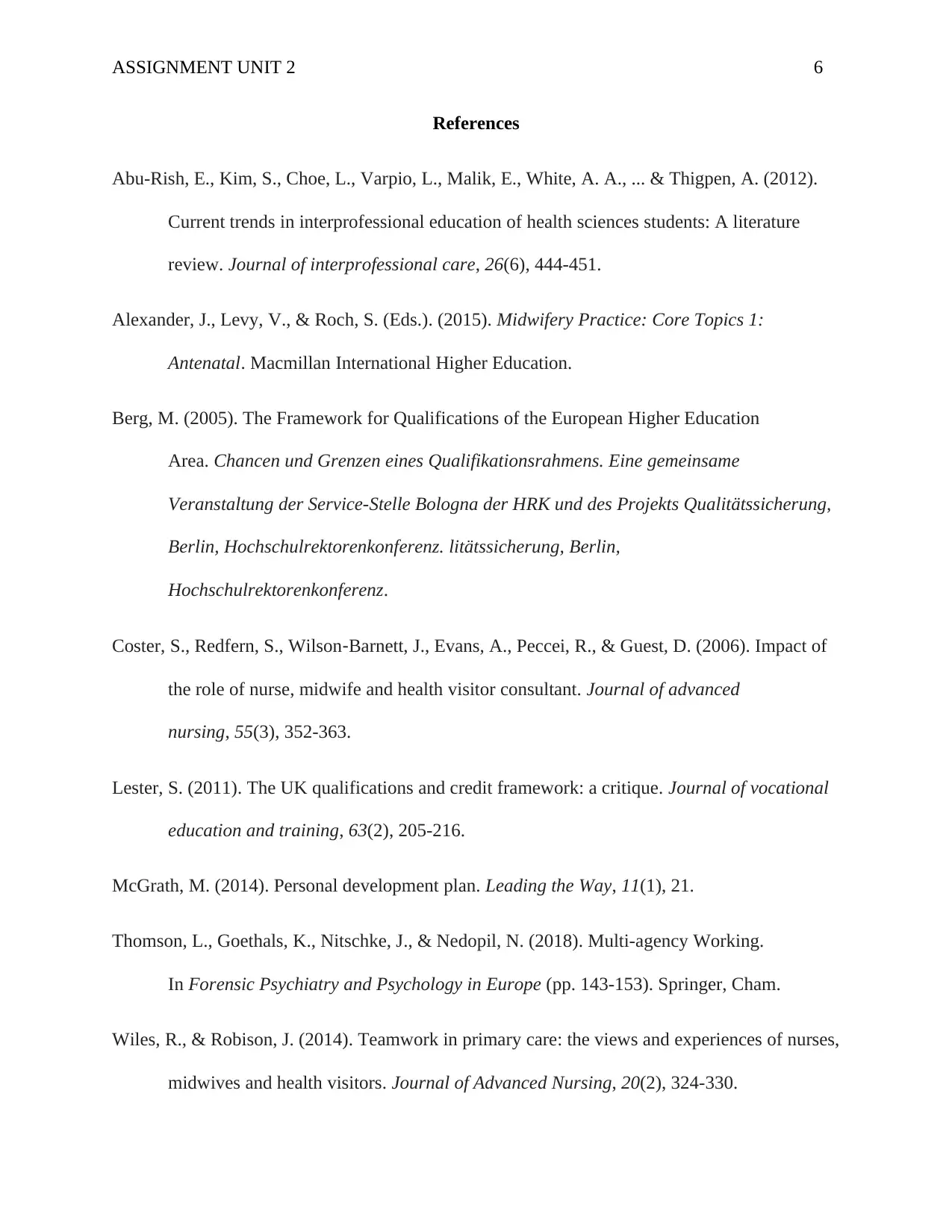
ASSIGNMENT UNIT 2 6
References
Abu-Rish, E., Kim, S., Choe, L., Varpio, L., Malik, E., White, A. A., ... & Thigpen, A. (2012).
Current trends in interprofessional education of health sciences students: A literature
review. Journal of interprofessional care, 26(6), 444-451.
Alexander, J., Levy, V., & Roch, S. (Eds.). (2015). Midwifery Practice: Core Topics 1:
Antenatal. Macmillan International Higher Education.
Berg, M. (2005). The Framework for Qualifications of the European Higher Education
Area. Chancen und Grenzen eines Qualifikationsrahmens. Eine gemeinsame
Veranstaltung der Service-Stelle Bologna der HRK und des Projekts Qualitätssicherung,
Berlin, Hochschulrektorenkonferenz. litätssicherung, Berlin,
Hochschulrektorenkonferenz.
Coster, S., Redfern, S., Wilson‐Barnett, J., Evans, A., Peccei, R., & Guest, D. (2006). Impact of
the role of nurse, midwife and health visitor consultant. Journal of advanced
nursing, 55(3), 352-363.
Lester, S. (2011). The UK qualifications and credit framework: a critique. Journal of vocational
education and training, 63(2), 205-216.
McGrath, M. (2014). Personal development plan. Leading the Way, 11(1), 21.
Thomson, L., Goethals, K., Nitschke, J., & Nedopil, N. (2018). Multi-agency Working.
In Forensic Psychiatry and Psychology in Europe (pp. 143-153). Springer, Cham.
Wiles, R., & Robison, J. (2014). Teamwork in primary care: the views and experiences of nurses,
midwives and health visitors. Journal of Advanced Nursing, 20(2), 324-330.
References
Abu-Rish, E., Kim, S., Choe, L., Varpio, L., Malik, E., White, A. A., ... & Thigpen, A. (2012).
Current trends in interprofessional education of health sciences students: A literature
review. Journal of interprofessional care, 26(6), 444-451.
Alexander, J., Levy, V., & Roch, S. (Eds.). (2015). Midwifery Practice: Core Topics 1:
Antenatal. Macmillan International Higher Education.
Berg, M. (2005). The Framework for Qualifications of the European Higher Education
Area. Chancen und Grenzen eines Qualifikationsrahmens. Eine gemeinsame
Veranstaltung der Service-Stelle Bologna der HRK und des Projekts Qualitätssicherung,
Berlin, Hochschulrektorenkonferenz. litätssicherung, Berlin,
Hochschulrektorenkonferenz.
Coster, S., Redfern, S., Wilson‐Barnett, J., Evans, A., Peccei, R., & Guest, D. (2006). Impact of
the role of nurse, midwife and health visitor consultant. Journal of advanced
nursing, 55(3), 352-363.
Lester, S. (2011). The UK qualifications and credit framework: a critique. Journal of vocational
education and training, 63(2), 205-216.
McGrath, M. (2014). Personal development plan. Leading the Way, 11(1), 21.
Thomson, L., Goethals, K., Nitschke, J., & Nedopil, N. (2018). Multi-agency Working.
In Forensic Psychiatry and Psychology in Europe (pp. 143-153). Springer, Cham.
Wiles, R., & Robison, J. (2014). Teamwork in primary care: the views and experiences of nurses,
midwives and health visitors. Journal of Advanced Nursing, 20(2), 324-330.
⊘ This is a preview!⊘
Do you want full access?
Subscribe today to unlock all pages.

Trusted by 1+ million students worldwide

ASSIGNMENT UNIT 2 7
1 out of 7
Related Documents
Your All-in-One AI-Powered Toolkit for Academic Success.
+13062052269
info@desklib.com
Available 24*7 on WhatsApp / Email
![[object Object]](/_next/static/media/star-bottom.7253800d.svg)
Unlock your academic potential
Copyright © 2020–2025 A2Z Services. All Rights Reserved. Developed and managed by ZUCOL.





